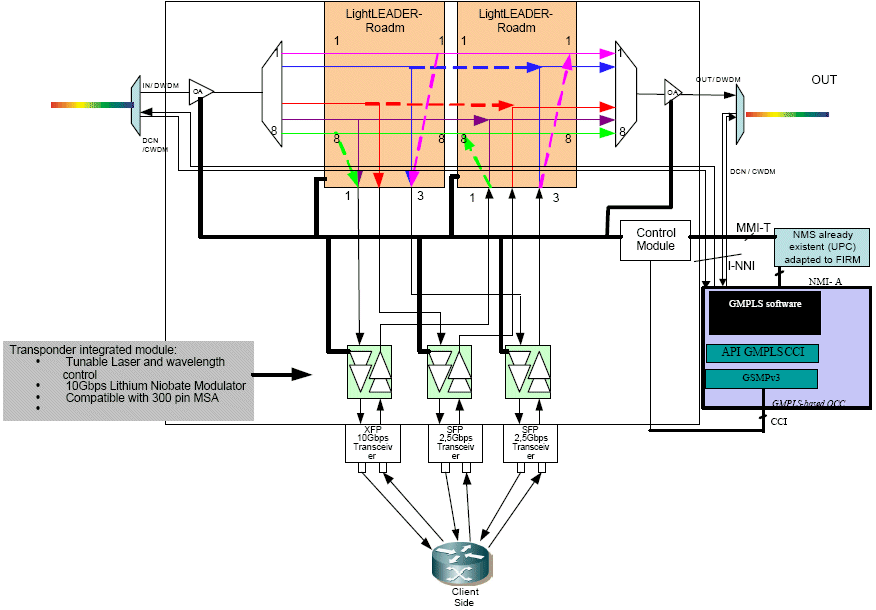

- Introduction -
FIRM aims to deploy a field trial consisting of an optical transport network based on ROADMs (Reconfigurable Optical Add/Drop Multiplexing) with GMPLS (Generalised Multi-Protocol Label Switching) compliance to set up and tear down light-paths dynamically under an ASON (Automatic Switched Optical architecture. FIRM will develop an integrated system by turning a static OADM into a ROADM with tuneable transceivers, introducing embedded intelligence inside the system and developing an open CCI (Communications Controller Interface).

- Main focus -
The ROADM enables unprecedented flexibility for the network manager. The network will be reconfigurable on the fly, allowing frequent changes in network connectivity, multicasting and broadcasting. OADMs on the market are either fixed or, at best, manually reconfigurable, and wavelengths can only be routed to a limited number of ports, thus leading to inherent limitations. The proposed innovative ROADM enables on demand provisioning and improves the QoS provided to customers. By using a novel technology of multicast-capable optical switches and tuneable transponders together with a unified control plane (GMPLS), R-OADM provides innovative services and protection schemes, such as drop and continue (for inter-ring connectivity) and multi-drop, which enables multicast/broadcast and can be used for truly O-VPN (Optical Virtual Private Network). The FIRM project focuses on software developed to control and manage an R-OADM and to enable new services. This software shall reduce the limitations of today's networks and increase their QoS while reducing capital and operating expenditures (CAPEX and OPEX). By upgrading existing products with the integration of external devices, a cost-effective solution can be offered within a short time. This solution will address seamless migration towards dynamic networks. Standard Single Mode Fiber imposes the use of chromatic dispersion compensation module when operating at 10 Gbit/s with reach beyond 80 km. The project will implement and test new transmission fiber to avoid dispersion compensation module for longer reach and to minimize non-linear effects in WDM operation.



- Approach -
The FIRM project is subdivided in six work packages that will assure the achievement of the following goals:
- Implementation strategy for Next Generation Optical Networks: Business model and techno-economic viability analysis in a short/medium-time-scale.
- Interoperability of Fully Optical Components: This will assure a successful integration through a correct assembly of optical components from different providers, guaranteeing an efficient interoperability between the resources they share. A comprehensive control-module system with embedded intelligence to control and monitor all the components of the ROADM will be achieved.
- Implementation of CCI GMPLS compliance: The lack of some standards in the field of optical networking is one of the factors which is more severely limiting the implementation of truly "optical layer products". FIRM plans to collaborate with some standards definition groups.
- Wide variety of access clients interfaces: The cost-effective integrated system solution will be capable of integrating several access technologies as 10Gigabit Ethernet, 1GEth, CWDM (Coarse Wavelength-Division Multiplexing), and SDH (Synchronous Digital Hierarchy) among others. These clients will use an easy and cheap XFP (eXtensible Filtering Pipelines) or SFP (Small-Form Pluggable) transceivers, which are the last current industry development.
- Provision of a Pan-European testbed facility for Optical Transport Networks: The FIRM field trial, with the R-OADM developed, will provide an open and intelligent optical network to companies or research centers that do not have the possibility to evaluate their products in a real environment with broadband services or applications and real end-users.
- Optical Network Protection: There must be automatic protection at transport network level to guarantee signal integrity.


- Main results -
The main result of the project will be a reconfigurable, control-and-management (C&M) enabled OADM (FIRM ROADM), which will be an integrated solution to allow a technology evolution without replacing currently static OADMs. This will be achieved through a node controller with C&M interfaces and the addition of tuneable/reconfigurable elements. An ASON and all-optical WDM switching field trial will be built in the last phase of the project. This field trial will be composed of FIRM ROADMs, a GMPLS control plane, tuneable lasers up to 10Gbps and real end-users. Moreover, a basic Network Management System (NMS) will be adapted to trigger connection requests (soft-permanent) as well as to manage remotely the active optical devices of the FIRM ROADMs. In addition, FIRM will provide a wide range of broadband and digital applications to stress the field trial network and test its performance. Also, new transmission fibre allowing to suppress chromatic dispersion compensation in metropolitan networks will be implemented and system-validated. Finally, an effort in contributing to standard development of control/transport interfacing will be made through collaboration with the IETF, ITU-T and OIF, among others.


- Impact -
Telecommunication networks are emerging as the central link of the information-based economy and society. The common denominator of emerging communication services is a robust, flexible and intelligent network infrastructure. Focusing on the development of ROADMs, the FIRM project contributes to the evolution from current SDH/ATM infrastructures to intelligent and flexible all-optical networks. FIRM contributes to the development of technologies and architectures that allow a generalized availability of broadband access, which is a key enabler to the wider deployment of the information and knowledge-based society and economy. This is done by defining network and network node architectures, concepts and solutions for all optical transport networks which will enable increased bandwidth capacity in the underlying optical core and metro networks, proportional to the expected evolution in user requirements and services. These new and efficient concepts for network management and control will lower the operational and capital costs (OPEX and CAPEX) and will enhance the delivery of new services and end-to-end connectivity. Thus, FIRM will contribute to enhance Europe's competitiveness in the development of flexible and intelligent all-optical networks.







